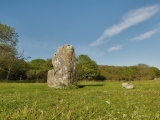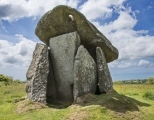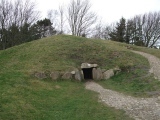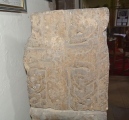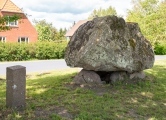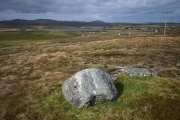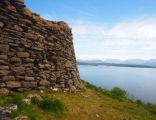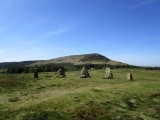Andy Burnham's Blog, page 233
May 25, 2019
Devil's Quoit (Stackpole)
Standing stone 1.7m tall in the Stackpole Warren nature reserve. Lots of other interesting stones and settlements around here. It is thought to stand on the site of a circular timber structure that burnt down around 1395 BC. Though it now stands alone, the stone probably formed part of an arrangement of smaller stones. About 940 BC a cremation burial was added to the earlier monument. The site was reused in the Iron Age and Romano-British period.
Published on May 25, 2019 06:15
May 24, 2019
Gumfreston Holy Wells
A very evocative site in Pembrokeshire (Sir Benfro) arising below the medieval church, down a small lane off the road to Tenby. The wells were said to be of different qualities - one pure, one sulphur and one chalybeate. Coflein say: The proximity of the wells to the church suggests this is an example of a Christian site chosen in the Dark Ages to absorb an earlier pagan well-cult.
Published on May 24, 2019 06:02
May 22, 2019
Trethevy Quoit
Volunteers wanted for archaeological dig at Trethevy Quoit, July 9th - 12th 2019. An ancient Neolithic burial chamber, standing nine feet high and consisting of five stones surmounted by a huge capstone. One of the uprights seems to have fallen inwards and the capstone has a terrific slope.
Published on May 22, 2019 09:59
Denghoog Sylt
Help to save one of the best preserved megalithic tombs in Germany: Petition . Famous Passage Grave on the island of Sylt.
Entry into the tomb is restricted, especially in winter.
Entry into the tomb is restricted, especially in winter.
Published on May 22, 2019 00:50
May 21, 2019
Holy Trinity (Rolleston)
Holy Trinity Church in Rolleston, near Newark is described as "a large and interesting multi-period church with its origins perhaps in th late 11th century; it has one of the largest collections of cross slabs and slab fragments in Nottinghamshire".
Published on May 21, 2019 13:15
Døjringe Langdysse 1
Pretty much every Langdysse (Long Barrow) and dolmen in this area of Denmark north of Sorø worth visiting has now been mapped by our member Torben Kristiansen Link to our Interactive Map. Langdysse (Long Barrow) in Sorø
Published on May 21, 2019 13:10
May 19, 2019
Stebno Stone Cross
A massive monolithic stone cross, in a beautiful setting on the ridge above the Stebno pond in Bohemia, Czech Republic. It is said to be a medieval propitiatory cross, although its true origin is unknown. Taking into account that this region is labelled as the centre of "local megalithic culture", it could also be a much older monument, later Christianised.
Published on May 19, 2019 15:45
Callanish 14
A standing(?) boulder on the hill top. From the position of this site, Callanish 1, 2,3 and 4 can be seen. If you are dedicated, you can find it from the entrance to Callanish 3 beyond the closest house across the road. This is also the starting point to visit Callanish 10.
Published on May 19, 2019 15:41
Tirefour Castle
A well-preserved broch on Lismore Island, Argyll with walls of 4,5 m thickness and 12 m diameter. The outer face of the wall is up to 5 m high. The entrance is orientated to the SW. NE and SW from the broch there are remains of the outworks.
Published on May 19, 2019 15:31
May 18, 2019
Green Bank (Lord Stones Country Park)
This is a very modern stone circle erected about 2013 when the Lord Stones Country Park and restaurant reopened under new owners. Actually its more of a semi circle with its inner arc facing easterly. Located on the summit of Green Bank there are extensive views over the Tees Plain.
Published on May 18, 2019 12:35

